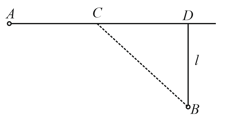An elevator car whose floor to ceiling distance is equal to , starts ascending with constant acceleration , after the start a bolt begins falling from the ceiling of the car. Find,
the bolt's free-fall time,
the displacement and the distance covered by the bolt during the free-fall in the reference frame fixed to the elevator shaft.
(Take )
the bolt's free-fall time,
the displacement and the distance covered by the bolt during the free-fall in the reference frame fixed to the elevator shaft.

Important Questions on PHYSICAL FUNDAMENTALS OF MECHANICS
From point located on a highway (as shown) one has to get by car as soon as possible to point located in the field at a distance from the highway. It is known that the car moves in the field times slower than on the highway. At what distance from point one must turn off the highway?

A point travels along the -axis with a velocity whose projection is presented as a function of time by the plot.

Assuming the coordinate of the point at the moment , draw the approximate time dependence plots for the acceleration , the coordinate and the distance covered .
the mean velocity
the modulus of the mean velocity vector
the modulus of the mean vector of the total acceleration if the point moved with constant tangent acceleration.
the velocity and the acceleration of the particle as functions of time,
the time interval taken by the particle to return to the initial points, and the distance covered during that time.
At the moment a particle leaves the origin and moves in the positive direction of the -axis. Its velocity varies with time as , where is the initial velocity vector whose modulus equals . Find,
the coordinate of the particle at the moments of time and ,
the moments of time when the particle is at the distance from the origin,
the distance covered by the particle during the first and ; draw the approximate plot .
the time dependence of the velocity and the acceleration of the particle,
the mean velocity of the particle averaged over the time that the particle takes to cover the first metres of the path.
